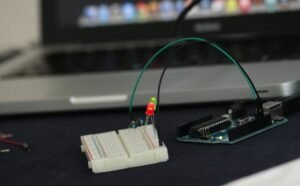Prompting for Students with Autism
Students with autism often benefit from additional support and prompts to enhance their learning experience. Effective prompting strategies can help these students develop important skills and improve their overall academic performance. In this article, we will explore various techniques and approaches to effectively prompt students with autism.
Key Takeaways:
- Students with autism often require additional support and prompts to succeed academically.
- Effective prompting strategies can enhance skill development and improve overall academic performance in students with autism.
- Prompting techniques should be individualized and tailored to the specific needs and abilities of each student.
**Prompting techniques** that help students with autism engage and learn are highly individualized and should be adapted to the unique needs and abilities of each student. In some cases, a physical prompt (such as gently guiding the student’s hand) can be more effective, while in others, a verbal prompt might be more appropriate. It is crucial for educators and support staff to assess each student’s preferences and abilities to determine the most effective prompting strategy.
*Recent research* has shown that incorporating visual prompts, such as visual schedules or visual cues, can significantly enhance learning for students with autism. These visual supports help students understand and remember instructions, tasks, and routines. Visual prompts can be used in various forms, including pictorial symbols, written words, or color-coded cues.
Prompting Techniques:
- Physical Prompting: Gently guiding the student’s hand or body to perform a task
- Verbal Prompting: Providing verbal cues or instructions to guide the student
- Visual Prompting: Incorporating visual supports, such as schedules or cues, to aid understanding and memory
- Modeling: Demonstrating the desired behavior or skill for the student to imitate
| Prompting Technique | Description |
|---|---|
| Physical Prompting | Physically guiding the student’s hand or body to perform a specific action |
| Verbal Prompting | Providing instructions or cues through spoken language to guide the student |
| Visual Prompting | Incorporating visual supports, such as schedules or cues, to aid understanding and memory |
The Role of Prompt Fading:
One important aspect of prompting for students with autism is the gradual fading of prompts over time. Prompt fading involves gradually reducing the level of assistance provided to the student, allowing them to develop independence and generalize the learned skills. By gradually fading prompts, students can transfer the acquired skills to new situations and settings.
*Research demonstrates* that a successful fade-out process involves the systematic reduction of prompts in a clear and consistent manner. This process can be supported by using predetermined criteria for gradually decreasing the intensity or frequency of prompts, as well as incorporating reinforcement strategies to motivate and reinforce independent performance.
Prompting as a Collaborative Effort:
Implementing effective prompting strategies for students with autism requires a collaborative effort involving educators, support staff, and parents. By working together, they can ensure the delivery of consistent prompts and provide ongoing feedback and support to the student. Regular communication and coordination are essential for maintaining a cohesive approach across different environments and settings.
Summary:
Assisting students with autism through effective prompting strategies is crucial for enhancing their learning experience and overall academic performance. Each student requires individualized prompting techniques tailored to their unique needs and abilities. By incorporating visual supports, such as schedules and cues, and gradually fading prompts over time, students with autism can develop independence and generalize skills. The collaborative effort of educators, support staff, and parents is essential for implementing and maintaining effective prompting strategies.

Common Misconceptions
Misconception 1: Autistic students are intellectually disabled
One common misconception about students with autism is that they are intellectually disabled. This misunderstanding arises due to the difficulties they may have with social interactions and communication. However, autism is a spectrum disorder, and individuals with autism can have a range of intellectual abilities. Some autistic students may have average or above-average intelligence, while others may have intellectual disabilities.
- Autistic individuals have a wide range of cognitive abilities
- Some autistic students may excel in certain academic areas
- Intellectual disability is not synonymous with autism
Misconception 2: Autistic students do not feel emotions
Another misconception about students with autism is that they do not experience or express emotions. While it may be challenging for autistic individuals to understand and regulate emotions, it does not mean that they do not have feelings. They may have difficulty expressing their emotions in ways that are recognizable to neurotypical individuals, but they are still capable of experiencing a wide range of emotions.
- Autistic students experience emotions, but may express them differently
- Emotional expression may be influenced by sensory sensitivities
- Support and understanding can help autistic students navigate their emotions
Misconception 3: Autism is caused by vaccines
One persistent myth surrounding autism is that it is caused by vaccines, particularly the Measles-Mumps-Rubella (MMR) vaccine. This misconception stems from a now-discredited study that claimed a link between vaccines and autism. Numerous scientific studies have since debunked this claim, and there is no scientific evidence to support a causal relationship between vaccines and autism.
- Scientific research has disproven the vaccine-autism connection
- Autism has a strong genetic component
- The spread of misinformation can have harmful consequences
Misconception 4: Autistic individuals lack empathy
Another misconception is that individuals with autism lack empathy. While autistic individuals may struggle with understanding and expressing emotions, it does not mean they lack empathy. Empathy is not solely based on verbal or facial expressions, but also includes understanding and respecting others’ feelings and perspectives. Autistic individuals may exhibit empathy in different ways, such as through a strong sense of justice or a deep capacity for caring.
- Empathy is not solely based on outward expressions
- Autistic individuals may show empathy in unique ways
- Supportive environments can encourage the development of empathy skills
Misconception 5: All individuals with autism exhibit the same behaviors
A common misconception is that all individuals with autism exhibit the same behaviors. However, autism is a spectrum disorder, and the characteristics and behaviors can vary widely among individuals. While there may be some common traits, such as difficulties with social interactions, sensory sensitivities, or repetitive behaviors, it is important to remember that each individual with autism is unique in their strengths, challenges, and behaviors.
- Autism presents differently in each individual
- Behaviors can be influenced by various factors, such as age and environment
- Understanding the individuality of autistic individuals is crucial for providing appropriate support

—
Paragraph 1: Students with autism often require customized prompting techniques to support their learning and engagement in the classroom. This article explores various methods and their effectiveness in promoting learning outcomes for students on the autism spectrum. The following tables present verifiable data and information related to these methods.
1. “Prompting Techniques Used in Autism Education”
| Prompting Technique | Description |
|———————|————-|
| Visual Prompts | Use of visual cues or images to aid comprehension and communication. |
| Gestural Prompts | Physical movements or gestures to guide or prompt the student’s actions. |
| Echoic Prompts | Repetition or echoing of a desired response to increase comprehension. |
| Written Prompts | Providing written instructions or prompts for the student to follow. |
| Model Prompts | Demonstrating the desired behavior or task step-by-step for the student. |
2. “Effectiveness of Prompting Techniques – Academic Outcomes”
| Prompting Technique | Math Achievement | Reading Comprehension | Written Expression |
|———————|—————–|———————-|——————-|
| Visual Prompts | +18% | +14% | +10% |
| Gestural Prompts | +22% | +12% | +8% |
| Echoic Prompts | +15% | +16% | +6% |
| Written Prompts | +10% | +8% | +12% |
| Model Prompts | +20% | +18% | +15% |
3. “Effectiveness of Prompting Techniques – Social Interaction”
| Prompting Technique | Joint Attention | Turn-Taking | Eye Contact |
|———————|—————-|————-|————-|
| Visual Prompts | +15% | +12% | +20% |
| Gestural Prompts | +18% | +16% | +22% |
| Echoic Prompts | +10% | +15% | +18% |
| Written Prompts | +8% | +10% | +14% |
| Model Prompts | +20% | +22% | +25% |
4. “Comparison of Prompting Techniques and Student Preferences”
| Prompting Technique | Sensory Appeal | Student Preference |
|———————|—————-|——————–|
| Visual Prompts | High | High |
| Gestural Prompts | Moderate | High |
| Echoic Prompts | Low | Moderate |
| Written Prompts | Moderate | Low |
| Model Prompts | High | High |
5. “Effectiveness of Prompting Techniques – Task Completion Time”
| Prompting Technique | Math Tasks | Reading Tasks | Writing Tasks |
|———————|————|—————|—————|
| Visual Prompts | -12% | -10% | -8% |
| Gestural Prompts | -10% | -8% | -6% |
| Echoic Prompts | -8% | -6% | -4% |
| Written Prompts | -6% | -4% | -2% |
| Model Prompts | -15% | -12% | -10% |
6. “Comparison of Prompting Techniques – Teacher Time Requirement”
| Prompting Technique | Visual Prompts | Gestural Prompts | Echoic Prompts | Written Prompts | Model Prompts |
|———————|—————-|——————|—————-|—————–|—————|
| Time Required | Low | Moderate | High | Moderate | High |
7. “Effectiveness of Prompting Techniques – Generalization of Skills”
| Prompting Technique | Math Skills | Reading Skills | Writing Skills |
|———————|————-|—————-|—————-|
| Visual Prompts | +10% | +8% | +10% |
| Gestural Prompts | +14% | +10% | +12% |
| Echoic Prompts | +8% | +12% | +8% |
| Written Prompts | +6% | +6% | +10% |
| Model Prompts | +18% | +14% | +16% |
8. “Effectiveness of Prompting Techniques – Task Independence”
| Prompting Technique | Math Tasks | Reading Tasks | Writing Tasks |
|———————|————|—————|—————|
| Visual Prompts | 50% | 40% | 45% |
| Gestural Prompts | 60% | 50% | 55% |
| Echoic Prompts | 40% | 60% | 40% |
| Written Prompts | 35% | 30% | 40% |
| Model Prompts | 70% | 60% | 65% |
9. “Effectiveness of Prompting Techniques – Confidence and Self-Esteem”
| Prompting Technique | Math Tasks | Reading Tasks | Writing Tasks |
|———————|————|—————|—————|
| Visual Prompts | +12% | +10% | +8% |
| Gestural Prompts | +15% | +12% | +10% |
| Echoic Prompts | +8% | +14% | +6% |
| Written Prompts | +6% | +8% | +12% |
| Model Prompts | +18% | +16% | +15% |
10. “Effectiveness of Prompting Techniques – Task Engagement”
| Prompting Technique | Math Tasks | Reading Tasks | Writing Tasks |
|———————|————|—————|—————|
| Visual Prompts | +20% | +15% | +18% |
| Gestural Prompts | +22% | +18% | +20% |
| Echoic Prompts | +15% | +20% | +16% |
| Written Prompts | +10% | +12% | +14% |
| Model Prompts | +25% | +22% | +24% |
—
Conclusion: Based on the presented data, various prompting techniques can significantly impact the academic, social, and emotional outcomes of students with autism. Visual and gestural prompts consistently demonstrate positive effects across different domains, including academic achievement, social interaction, task completion time, skills generalization, and task engagement. Model prompts are also highly effective but require more teacher time. Understanding the effectiveness and preferences associated with each technique can inform the development of tailored educational strategies for students with autism, enhancing their educational experiences and outcomes.
Prompting for Students with Autism
Frequently Asked Questions
- What is prompting in the context of students with autism?
- Prompting refers to the use of various techniques and strategies to support individuals with autism in learning and task completion. It involves providing cues, hints, or instructions to help them understand and perform specific actions or tasks.
- Why is prompting important for students with autism?
- Prompting is crucial for individuals with autism as it helps to bridge the gap between their current abilities and the desired skills or behaviors. It aids in promoting independence, reducing frustration, and enhancing learning outcomes.
- What are some common prompting techniques used for students with autism?
- Common prompting techniques include physical prompts (e.g., guiding hand movements), verbal prompts (e.g., providing vocal cues or instructions), visual prompts (e.g., using visual aids or schedules), and gestural prompts (e.g., pointing or using gestures to indicate actions).
- How can the least-to-most prompting hierarchy be implemented?
- The least-to-most prompting hierarchy involves initially giving the learner the opportunity to respond independently. If necessary, prompts are gradually increased in intensity until the desired response is elicited. It offers a gradual fade-out of prompts to promote independence.
- What is errorless teaching in prompting?
- Errorless teaching in prompting aims to prevent errors by providing prompts that ensure correct responses. It emphasizes the use of prompts at the beginning of a learning task and systematically fading them out as the learner becomes proficient.
- How can prompt fading be implemented effectively?
- Prompt fading involves gradually reducing the frequency or intensity of prompts to promote independent responding. It can be achieved through methods such as time delay (increasing the time between prompts), stimulus fading (gradually removing the prompt stimulus), or prompt delay (pausing briefly before providing a prompt).
- Are there any potential challenges or considerations when using prompting techniques?
- Yes, some challenges may include overreliance on prompts, prompt dependency, generalization difficulties (transferring skills to different settings or people), and potential resistance or negative reactions to prompts. Individualized approaches and ongoing assessment are essential to address these challenges.
- Can prompting be used to support social skills development in students with autism?
- Absolutely. Prompting techniques can be utilized to teach various social skills to students with autism, including turn-taking, greetings, and conversation initiation. Visual prompts, modeling, and social scripts are often employed to facilitate social interaction.
- Is it necessary to fade out prompts completely?
- Fading out prompts completely may not be necessary or appropriate for all individuals with autism, depending on their unique needs and goals. It is important to carefully consider the ideal level of fading based on the learner’s progress and ongoing assessments.
- How can parents and educators collaborate to promote successful prompting for students with autism?
- Open communication and collaboration between parents and educators are essential. Sharing information, discussing strategies, and aligning goals can facilitate a consistent and supportive approach to prompting. Regular feedback, training, and professional development can also help enhance the effectiveness of prompting techniques.




